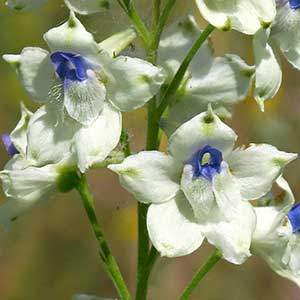Delphinium nuttallii subsp. ochroleucum
(synonym of Delphinium leucophaeum)
Delphinium andersonii
pale larkspur, white rock larkspur
Anderson larkspur, Anderson's larkspur, desert larkspur
30-60 cm.
(20-)30-60(-90) cm;
base reddish, glabrous.
blade round, 1.5-4 × 2-6 cm, nearly glabrous; ultimate lobes 5-30, width 2-8 mm (basal), 1-4 mm (cauline);
lobe width of proximal leaves less than 4 mm.
10-25-flowered, cylindric;
pedicel sigmoid (proximally spreading, distally ascending), 1-4(-6.8) cm, glabrous to puberulent;
bracteoles 2-6(-8) mm from flowers, green, linear, 4-6(-11) mm, ± puberulent.
sepals white or light yellow, spurs 9-11 mm;
lower petal blades 4-6 mm.
sepals dark blue, nearly glabrous, lateral sepals spreading to reflexed, 9-16 × 3-7 mm, spurs horizontal to slightly ascending, often decurved apically, 12-18 mm;
lower petal blades elevated, ± exposing stamens, 4-8 mm, clefts 1-4 mm;
hairs centered, mostly between claw and base of cleft, white.
17-32 mm, 4-5.5 times longer than wide, glabrous.
seed coat cells ± brick-shaped, cell margins ± undulate, surfaces smooth.
= 16.
= 16.
Delphinium nuttallii subsp. ochroleucum
Delphinium andersonii
Of conservation concern.
The range of morphologic features of Delphinium nuttallii subsp. ochroleucum (D. leucophaeum) is almost completely encompassed within that of D. nuttallii subsp. nuttallii. Sepal color is the only feature consistently separating the two subspecies. Were it not for the fact that any given population typically has plants of only one flower color, a rank of forma would be more appropriate.
(Discussion copyrighted by Flora of North America; reprinted with permission.)
In much of its range Delphinium andersonii hybridizes occasionally with members of the D. nuttallianum complex and apparently with D. parishii in at least one site in California. These three taxa, with D. scaposum, form an interesting group in that they appear to be ecological replacements for one another, with D. parishii occupying arid, hot deserts to the south and southwest, D. andersonii growing in cooler, higher latitude and altitude deserts farther north, D. scaposum in cool deserts farther east, and D. nuttallianum at higher elevations in much of the geographic range of the other three species. Delphinium andersonii is often mistaken for D. nuttallianum. Most individuals of D. andersonii (roots much larger and more fibrous; stems solidly attached to roots; fruits long, narrow, erect; inflorescences usually longer and narrower at base; and pedicel sigmoid) can easily be distinguished from D. nuttallianum (roots smaller and not fibrous; stems tenuously attached to roots; fruits shorter, proportionally thicker, spreading; inflorescences relatively shorter and wider at base; and pedicel nearly straight).
Although roots of Delphinium andersonii are quite similar to those of D. antoninum, the two taxa may be readily distinguished by most features that separate D. nuttallianum from D. andersonii. The name Delphinium menziesii was misapplied to D. andersonii by S. Watson.
(Discussion copyrighted by Flora of North America; reprinted with permission.)


